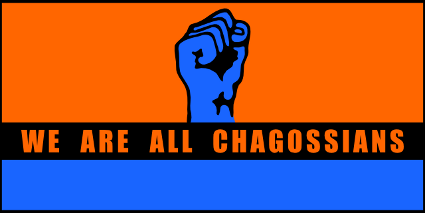Timeline of the Chagossian Exile
and the Base on Diego Garcia
1783--First inhabitants arrive in Chagos Archipelago as enslaved Africans; indentured Indians soon arrive helping form a new, unique society and a people first known as the Ilwa (Ilois).
1957/58--US Navy officials develop “Strategic Island Concept” to acquire islands for future bases. They identify Diego Garcia as their prime acquisition target.
1960--US Navy approaches Britain about building a base on Diego Garcia. Secret negotiations begin.
1964--During secret US/UK talks, US indicates desire for “exclusive control” of Diego Garcia “without local inhabitants.” UK officials agree.
1965--At US urging, UK pressures its colony Mauritius to cede Chagos and creates the British Indian Ocean Territory. This violates UN decolonization rules forbidding the division of colonies.
1966--“Exchange of Notes” gives US access to Diego Garcia for 50 years with automatic 20-year renewal. UK secretly agrees to remove Chagossians for $14 million hidden from Congress, Parliament.
1968--Chagossians in Mauritius for vacations or medical treatment are barred from returning home and marooned in Mauritius. UK limits supplies of food, medicines to help depopulate the islands.
1970--US Navy tells Congress Chagos has no permanent population as part of UK/US plan to “maintain the fiction” that Chagossians are transient workers and not indigenous to the islands.
1971--Construction begins on Diego Garcia. British agents and US Navy personnel gas and burn Chagossians’ pet dogs. Chagossians on Diego Garcia deported to Mauritius and Seychelles.
1972--UK pays Mauritius £650,000 to resettle Chagossians. UK, US admit newly independent Mauritius cannot resettle newcomers with this sum. Chagossians see no money for more than five years.
1973--Last Chagossians deported from other Chagos islands to Mauritius.
1975--Washington Post breaks the story in Western press, describes Chagossians living in “abject poverty” in Mauritius. One day of Congressional hearings held before interest fades.
1982--Chagossians hold hunger strikes, protests, and UK agrees to £4 million compensation. Some Chagossians receive ~$6,000 total. US spends hundreds of millions expanding Diego Garcia base.
2000--Chagossians challenge their exile in UK High Court. The court rules the expulsion was illegal.
2001--Diego Garcia base plays key role in US-led war in Afghanistan and, later, in the 2003 war in Iraq.
2004--After briefly allowing a return following 2000 ruling—but doing nothing to rebuild Chagossian society—the UK again bars them from returning, effectively overturning the 2000 victory.
2008--Chagossians challenge the new ban and win twice more in High Court. On the British government’s last appeal, the UK’s highest court overturns the lower courts, upholding the exile and colonial law.
2010--UK creates Chagos Marine Protected Area (MPA) with an exemption for the Diego Garcia base. A Wikileaks-released State Department cable shows UK, US officials agreed the MPA was best way to prevent Chagossians from going home.
2015--UK releases study confirming the feasibility of Chagossians resettling Chagos. UN Permanent Court of Arbitration rules UK acted illegally in creating an MPA.
2016--Despite the UK government’s own study showing the feasibility of a return, the government denies a return. It offers £40 million in assistance projects over 10 years. CRG refuses the compensation and the attempt to get them to drop their demand to go home.
2017--CRG supports the Mauritian Government at the UN, where General Assembly votes 94-16 to have the International Court of Justice (ICJ) rule on Mauritius’s challenge to UK sovereignty over Chagos and the expulsion of the Chagossians.
2019--The ICJ rules overwhelmingly in favor of Mauritius and the Chagossians, declaring the UK’s 1965 creation of the British Indian Ocean Territory “unlawful” and Mauritius the rightful sovereign of Chagos. The ICJ called on the UK to “end its continued administration of the Chagos Archipelago as rapidly as possible.” The UN General Assembly responds to the ICJ by passing a resolution 116–6 ordering the UK “to cooperate with Mauritius in facilitating the resettlement” of the Chagossians. Mauritius emphasizes its willingness to allow the US base to stay, publicly offering a 99-year lease.
2022--The UK government announces it will begin negotiations with the Mauritian government over Chagos and all remaining issues. Chagossians demand to be included in the negotiations about their future. To date, the UK has excluded them.
2023--Human Rights Watch, in a first for a major human rights organization, finds the US and UK committed “crimes against humanity” against Chagossians, including racial descrimination.
UK-Mauritius negotiations over Chagos continue without Chagossian participation. US officials have not assumed any public role in the negotiations but are likely deeply involved.
Olivier Bancoult, chair of the Chagos Refugees Group, and Liseby Élysée, who testified before the ICJ, are nominated for a Nobel Peace Prize. The Chagos Refugees Group is also nominated as an organization.
Chagossian litigation continues in UK courts.
